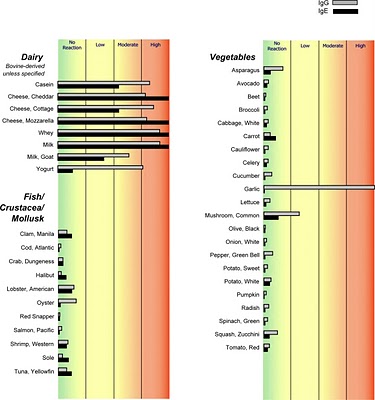When faced with the possibility of a food as the cause of dis-ease, most health practitioners normally only test for food allergies when testing for food intolerance is also indicated. Food intolerance however as prevalent as they are, and just as serious a condition, are often neglected and not tested for despite the availability of well-recognized laboratory diagnostic tools.
How and Why do these tests differ?
A food allergy versus an intolerance elicits different immune system responses. Where a food allergy can be fatal, necessitating extreme measures taken for the avoidance of the culprit, food intolerance can cause a number of digestive as well as psychological concerns that are not as detrimental but are nonetheless causative factors in dis-ease!
With approximately 80% of our immune system being in the gut (Gut-Associated Lymphoid Tissue make up 25% by weight of the gut mucosa and thus constitute the largest extra-thymic site of lymphocytes), our choice of food has a direct effect not only on the functioning of the immune system but also on our overall health as a result of the immune system’s reaction to these foods (1)!
Immune System’s Response:
Food Allergy- Abdominal pain or cramping
- Abnormal breathing (high-pitched, wheezing)
- Anxiety & Confusion
- Diarrhea
- Difficulty Swallowing
- Hives, itchiness
- Nasal congestion
- Nausea, vomiting
- Respiratory: Sinusitis, asthma, frequent ear infections, cough, mucous build-up
- Digestive: Irritable Bowel Syndrome, Crohn’s disease, Celiac disease
- Skin: Eczema (atopic dermatitis), acne, psoriasis, dry skin, itching
- Nervous System: Headaches, concentration disorders, drowsiness, depression, hyperactivity
- Musculoskeletal: Arthritis, joint and muscle pain, fibromyalgia, cramps
- Endocrine: Type 1 diabetes, Thyroiditis
Hippocrates, the father of modern medicine credited with the Hippocratic Oath “Do no harm” is also regularly paraphrased with his statement “let food be your medicine and medicine be your food”. Although the Hippocratic Oath is taken by all doctors who practice medicine, the latter statement has not yet been fully appreciated.
A skin prick test is often utilized to discover food allergies checking for IgE mediated immune response (an immediate response of the immune system). This test however is insufficient when testing for food intolerances. Food intolerances on the other hand, can be discovered through a serum laboratory test checking for IgG mediated immune response (a delayed immune response) or through a supervised Elimination Diet.
For your interest in the science behind the various ways in which our immune system responds to allergy causing particles (aka antigens), read below. To learn how a specific food intolerance can lead to the conditions listed above please seek the guidance of a licensed Naturopath who can address your specific case!
Food allergies (also referred to as hypersensitivity) are immunological reactions. Reactions due to hypersensitivity entail undesirable reactions of the immune system. Such reactions bring about tissue lesions and may sometimes be deadly. There are four main types of hypersensitive reactions according to which biological mechanism is involved.
-
Type I Hypersensitivity
Type I hypersensitivity involves IgE antibodies, of which the antigen (or protein particle in the causative agent) attaches to mast or basophiles receptors. This attachment triggers the degranulation of mastocytes or basophiles which releases histamine causing vasodilation. Clinical manifestations of Type I hypersensitive reactions include anaphylaxis (eventually leading to death), atopy and asthma.
-
Type II Hypersensitivity
Type II hypersensitivity appears when IgG or IgM antibodies react with certain antigens present on a cell. This leads to a lesion or a deadly breakdown of the cell. Clinical manifestations of this type of reaction include haemolytic anemia (for example in the case of the incorrect transfusion of incompatible blood), thrombocytopenia, or Goodpasture Syndrome.
-
Type III Hypersensitivity
Type III hypersensitivity stems from the formation of immune complexes, involving IgG antibodies. Such activation of the complement releases molecules which causes a localized vasodilatation and an attraction of neutrophiles. Clinical manifestations of this type of reaction which varies in accordance with the immune complexes deposit site are: serum sickness-like illnesses (such as nephrites, skin lesions, arthritis, vasculitis), or systemic lupus erythematosus. Immune complex deposit sites can include small blood vessels, articulations or glomerulus. Clinical reactions may take hours, days, or even weeks before arising.
-
Type IV Hypersensitivity
Type IV hypersensitivity involves cell-mediated immunity of the immune system together with the activation, by the antigen, of sensitized T4 cells which, in turn, release cytokines. The release of cytokines activates macrophages which cause localized tissue lesions. Clinical manifestations of this type of hypersensitivity include: contact dermatitis, chronic rejection of transplants, multiple sclerosis and the Mantoux (TB) test.
Edit (Nov. 3, 2018): For more information and links to studies please see this article and this article


